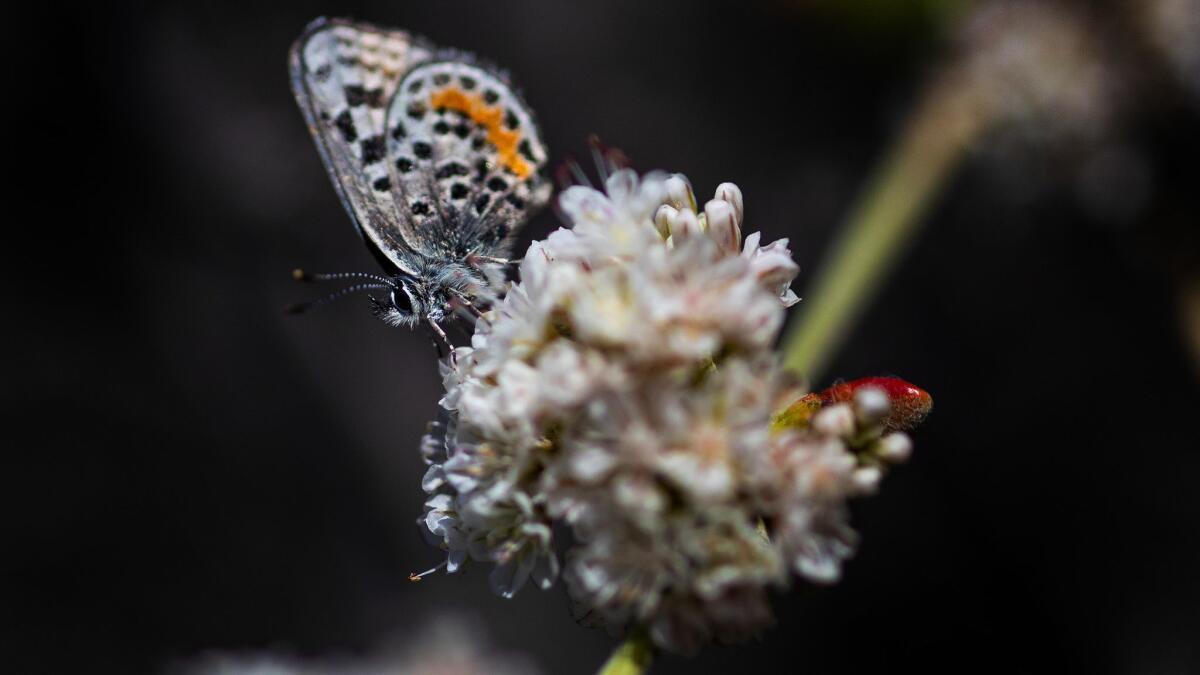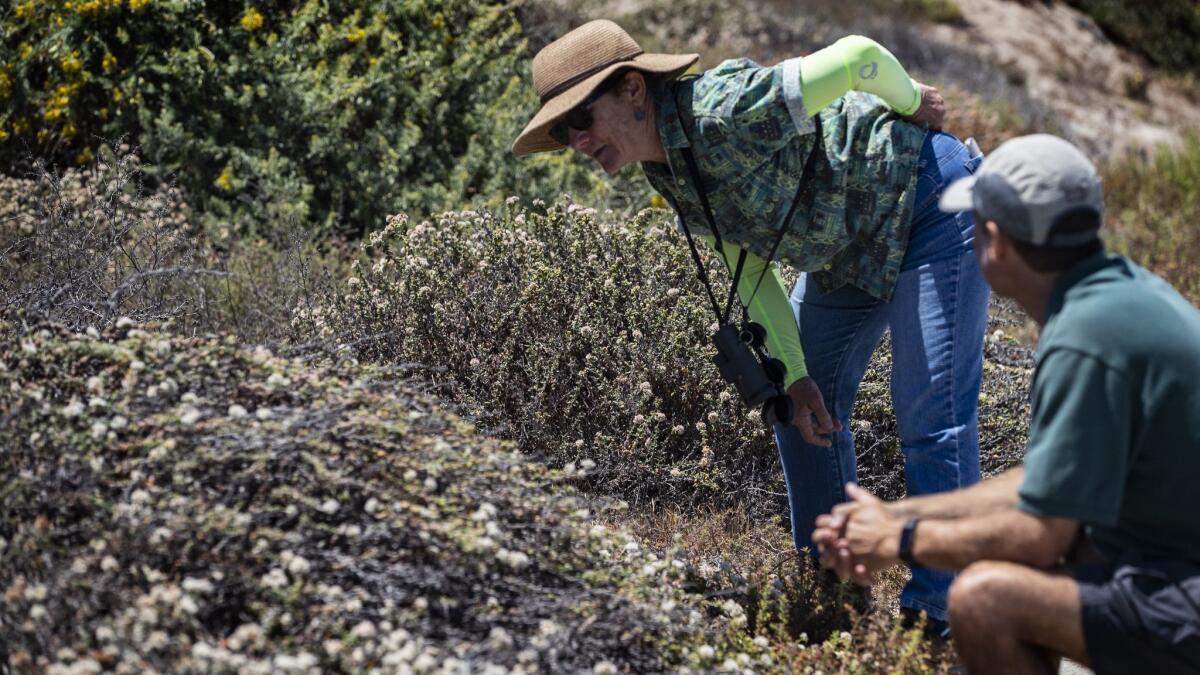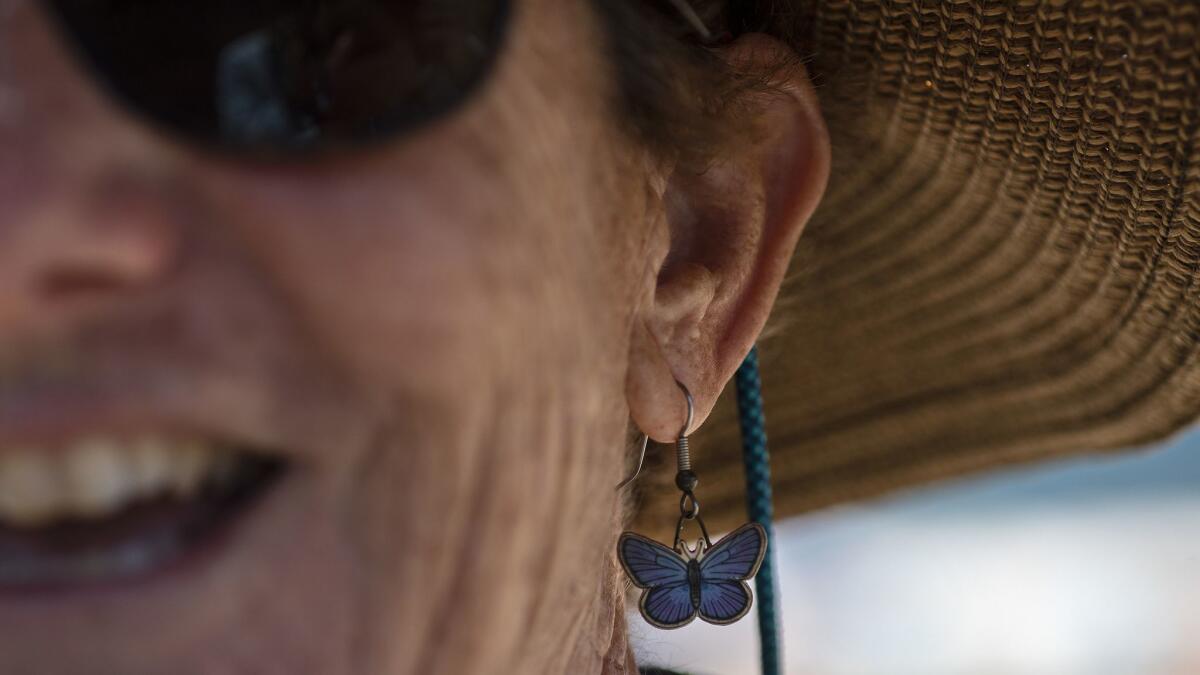Column: How ripping out a plant species is helping save an endangered Southern California butterfly

I’m a sucker for a good comeback story, which is why, instead of the usual morning run on Saturday, I found myself crouching on a slope next to the beach in Torrance, staring into pinkish clumps of sea-cliff buckwheat and the dormant brown stalks of California bush sunflowers.
I was looking for the once-elusive El Segundo blue butterfly — no bigger than your thumbnail — and in no time I found one, a female, perched on a buckwheat blossom, her wings closed as she drank its nectar. On the other side of the blossom, a bee was doing its thing.
The little El Segundo blue was the very first insect to make the endangered species list, back in 1976. Existing only in the coastal dunes between LAX and Palos Verdes, it has made a heartwarming return thanks to the efforts of environmentalists, who have persuaded various cities and jurisdictions to rip out ubiquitous fields of ice plant and restore the native habitat that is vital to the survival of this rare creature.
Among those eco-heroes is Ann Dalkey, a retired marine biologist who worked at the Hyperion Treatment Plant for 22 years. On Saturday, she led a group of locals on a tour of some of the restored butterfly habitat, looking every inch the insect collector in a sun hat and protective clothing, with a pair of binoculars slung around her neck.
Half an hour into our foray, she pointed and raised her voice: “Oooh! Look! There’s a good male dogfight over there!”
A bunch of male butterflies were flitting around, competing for the attention of a female, who had already paired off with a mate.
I will have to take her word for it. As observant as I was trying to be, all I saw was buckwheat and dead sunflowers.
Still, I was glad to know there are male El Segundo blues out there competing for the ladies. At least they now have a fighting chance for survival.
::

This butterfly, like so much other wildlife, is threatened in general by the intense urbanization of the coast, and in particular by a dearth of coastal buckwheat, its food source. The butterfly pollinates the buckwheat, which provides nectar for the butterfly, which provides a tasty meal for birds and lizards. Yes, the butterfly has a short but important life span of maybe a week.
For years, biologists were able to prevent the extinction of the El Segundo blue by nurturing and protecting them in three places along the coast: the sand dunes west of LAX, at the Chevron El Segundo refinery, and on a privately owned piece of land in Palos Verdes. All of those locations were off-limits to the public.
In 2004, a coalition of residents and two nonprofits — the Urban Wildlands Group and the LA Conservation Corps’ SEA Lab (which hires and trains underserved young adults to educate schoolchildren) led the effort to restore a little patch of land in Redondo Beach. They ripped out a carpet of ice plant, planted coast buckwheat and, three years later, butterflies turned up in the dunes there.
This came as a shock to scientists, who believed they were too sedentary to make forays into new territory.
“Hey, nobody told Mama butterfly that she could not fly here from Malaga Cove,” Dalkey said.
Not everyone was thrilled that an endangered insect had shown up on a heavily used urban beachfront. Dalkey said environmentalists were even accused of planting the butterflies in the new location, a feat that is probably as impractical as it is illegal, given the butterfly’s protected status.
It doesn’t take an illegal act to help the El Segundo blue survive. Anyone who lives near the beach in the corridor that stretches from Palos Verdes to Santa Monica, Dalkey said, can help by planting buckwheat, bush sunflowers, purple sage, blue elderberry or bladderpod, all hospitable to the butterfly.
Which brings me to ice plant, a non-native, invasive plant that has been used over the years for erosion control by misguided Californians. Butterfly-wise, it is an enemy of all that is good and holy. It releases salt into the soil, which inhibits the growth of many natives, said Amy Breschini, a master gardener in San Luis Obispo County. It offers nothing in the way of food to animals, and it out-competes native plants for water, light and space.
“Ice plant is problematic in coastal areas and beaches in California,” said Cal Poly San Luis Obispo botanist Matt Ritter, who dismisses it as a “weed” in his indispensable new book, “California Plants: A Guide to Our Iconic Flora.” “I also think it’s ugly, but that is neither here nor there.”
(Unlike eucalyptus, a controversial tree with as many fans as detractors, I don’t know anyone who would go to the mat for ice plant.)
“We call ice plant ‘ecological Styrofoam,’” Dalkey told me. “We’ve paved over paradise, and it doesn’t take a lot of effort to bring it back.”
::

I stopped to chat with Jim Montgomery, a JPL engineer and environmental activist who was on the tour. He and his wife have ripped out their old landscaping and planted butterfly-friendly plants.
“These little islands of life, linking them together, that’s Ann’s goal,” Montgomery said.
Montgomery, who grew up playing in the woods in Michigan, was part of the years-long effort that saved 600 acres of the Ballona Wetlands in Marina del Rey from development. He also fought for the preservation of the 43-acre Madrona Marsh, a wetland in the middle of Torrance that was slated for development but is now a nature education center.
He wants to make sure that city kids in Southern California get the chance to experience nature as he once did.
“I feel sorry for kids born in an urban jungle,” he said.
I’m not sure that I would describe Southern California cities in such dire terms; after all, the beaches and mountains are easily accessible, but I respect his commitment to ecologically meaningful open spaces.
Saturday morning’s butterfly walk was organized by the Beach Cities Health District as part of its “Blue Zones Project,” which aims to help people stay healthy and live longer by keeping them engaged in their communities.
If watching butterflies have sex will help me live longer, then I’m all in.
More to Read
Sign up for The Wild
We’ll help you find the best places to hike, bike and run, as well as the perfect silent spots for meditation and yoga.
You may occasionally receive promotional content from the Los Angeles Times.







